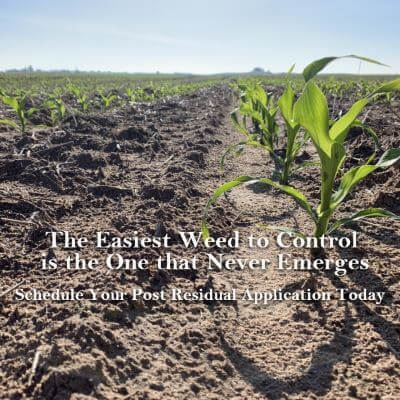Overlapping Residual for Optimizing Weed Control
May 20, 2020

Spring has sprung and the warm days seem to be here to stay. Along with the warmer weather, we have recently received some very nice rains across our territory. These rains have helped our spring crops take off growing and our wheat to recover some from the later freezing nights we had a couple weeks ago.
Unfortunately, with rain and warmer soil temperatures also comes the germination and emergence of annual weeds. Crabgrass and pigweeds can be found in fields throughout Central Kansas this week. Pigweeds can grow as much as an inch per day, so that 1-inch pigweed can be a 6-inch pigweed within a week and have over 30 growing points. Pigweeds and grasses compete with our crops for moisture, sunlight, and nutrients and can be detrimental to yield. If you wait until you can see the weeds down the field, it is often too late for complete control.
Residual herbicides help control weeds by preventing germination and emergence. At this time in the weed life cycle, it only has one growing point and is easily controlled. After emergence, weeds can quickly put on multiple growing points, making them much harder to control.
Many residual herbicides can control weeds for about 14-21 days after application and incorporation by a rain/watering event. While it is hard to want to spray a “clean field”, the best weed management strategy is to plan another residual herbicide application just inside of that 21-day window. This overlapping of residual products will help prevent a lapse in coverage that would allow pesky weeds to emerge. The main goal of overlapping residuals is to help prevent weed emergence until the crop can reach canopy stage.
We have residual products available for corn, soybeans, and grain sorghum. While the products are different, the plan is basically the same:
For more information on the best herbicide program for your operation, speak to your Great Bend Co-op Agronomist.
Unfortunately, with rain and warmer soil temperatures also comes the germination and emergence of annual weeds. Crabgrass and pigweeds can be found in fields throughout Central Kansas this week. Pigweeds can grow as much as an inch per day, so that 1-inch pigweed can be a 6-inch pigweed within a week and have over 30 growing points. Pigweeds and grasses compete with our crops for moisture, sunlight, and nutrients and can be detrimental to yield. If you wait until you can see the weeds down the field, it is often too late for complete control.
Residual herbicides help control weeds by preventing germination and emergence. At this time in the weed life cycle, it only has one growing point and is easily controlled. After emergence, weeds can quickly put on multiple growing points, making them much harder to control.
Many residual herbicides can control weeds for about 14-21 days after application and incorporation by a rain/watering event. While it is hard to want to spray a “clean field”, the best weed management strategy is to plan another residual herbicide application just inside of that 21-day window. This overlapping of residual products will help prevent a lapse in coverage that would allow pesky weeds to emerge. The main goal of overlapping residuals is to help prevent weed emergence until the crop can reach canopy stage.
We have residual products available for corn, soybeans, and grain sorghum. While the products are different, the plan is basically the same:
- Apply 1st Residual Product right before or immediately following planting
- Apply 2nd Residual Product 14-21 days Post Plant, typically just before canopy of the crop
- Crop Canopy should help with weed suppression after the next 14-21 days
- If a hail event should remove crop canopy, some residual products may be applied later in the growing season, check labels carefully for details
For more information on the best herbicide program for your operation, speak to your Great Bend Co-op Agronomist.